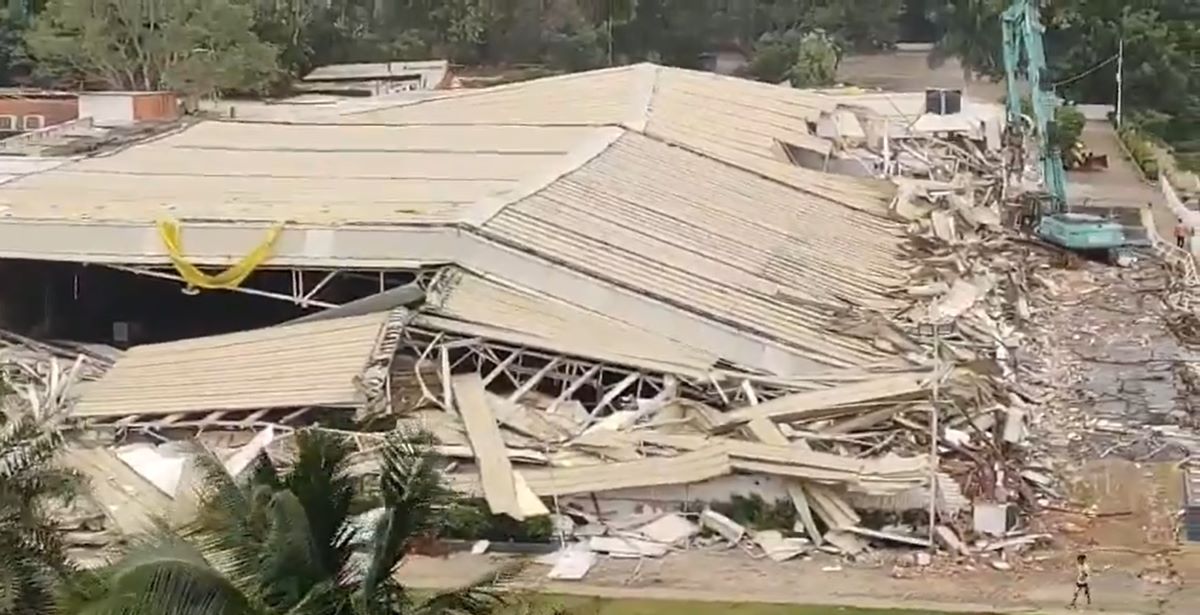Just as HYDRAA revs up its drive against buildings in the Full Tank level (FTL) and buffer zones of lakes, political analyst Prof K Nageshwar posed 10 questions to the recently created institution.
Published Aug 27, 2024 | 7:00 PM ⚊ Updated Aug 27, 2024 | 7:00 PM

The demolished N-Convention Centre. (Screengrab)
The Hyderabad Disaster Response and Asset Monitoring and Protection Agency (HYDRAA) began operations less than two months ago, and has already submitted a report to the state government about 166 “encroachments” removed and nearly 44 acres reclaimed near lakes, parks and nalas; this has stirred a controversy, as bulldozers are pressed into service to remove buildings said to encroach upon the area of water bodies.
The Telangana High Court has now issued guidelines to HYDRAA that must be followed for initiating action against encroachments and unauthorised buildings.
Just as HYDRAA revs up its drive against buildings in the Full Tank level (FTL) and buffer zones of lakes, political analyst Prof K Nageshwar posed 10 questions to the recently created institution, whose chairman is the chief minister himself.
The questions come just as HYDRAA draws a great deal of negative publicity, after demolishing N-Convention Centre, owned by popular Telugu actor A Nagarjuna. Other buildings owned by prominent personalities have also been brought down.
1) Will HYDRAA take the task entrusted to it to its logical end or will the activity which began with a bang, end in a whimper? Under the previous dispensation too, similar attempts were made but they stopped abruptly — the removal of unauthorised constructions in Ayyappa Society in Hyderabad, for instance. Will HYDRAA be able to clean up all the lakes in Hyderabad by removing the illegal structures or will it remain just some kind of a temporary hungama?
2) Will HYDRAA restrict its activity only to the protection of lakes and nalas or will it reclaim government lands like public places, parks?
3) Will HYDRAA be able to pull down the buildings of powerful politicians? Bharat Rashtra Samithi leader KT Rama Rao had even listed the names of Congress leaders — Revenue Minister Ponguleti Srinivasa Reddy, and prominent leaders KVP Ramachandra Rao, Madhu Yashki Goud, Vivek Venkata Swamy and even chief minister Revanth Reddy himself. Will HYDRAA be able to go beyond the consideration of political power and pull down all illegal buildings?
It is a fact that the demolition of buildings in the FTL and buffer zones of lakes is getting appreciation from the people. In Gandipet, the people expressed solidarity with the agenda of HYDRAA.
It is quite natural for common people to support action that goes against affluent sections of society. When HYDRAA was demolishing the buildings of the well-to-do, there was no protest from any political party either. The political parties were caught in a catch 22 situation — they could not oppose demolition being done to clear the areas of lakes and nalas, as this was shown to be a good cause. But will HYDRAA go after all encroachers, regardless of the party they belong to?
4) What will be the course of action for HYDRAA when it comes to pulling down buildings belonging to the poor or middle-class sections of society? Such buildings cannot be demolished ruthlessly, and the political parties too would rise to defend property owners in such cases. The owners of these properties may have purchased them without realising they were illegal. They may have been sold several times over a period of time, and the current owner may have been unaware of the illegality involved in the construction at the time of purchase. What would you do in such cases?
5) How will HYDRAA deal with owners who produce the necessary clearances and permissions from the government for buildings that actually fall in the FTL and buffer zones? BRS MLA Palla Rajeshwar Reddy said he had obtained all clearances from the state government before he built the buildings for his educational institutions. For a BRS leader to get clearances from the BRS government was easy, whether the construction was legal or not. What would you do with those who had given clearances for buildings that came up in prohibited zones? Will you take any action if an officer is found guilty of giving clearances for illegal construction?
6) You are razing buildings; that is one aspect of the problem. Will you also prosecute the officials, ministers and builders who allowed them to come up?
7) How long will it take to complete the task of freeing lakes and nalas of encroachment? What are the challenges likely to come up?
8) As far as N-Convention Centre of Akkineni Nagarjuna is concerned, there is a controversy – the HYDRAA commissioner says N-Convention Centre had no clearances, and there were no court stay orders; the commissioner referred to the Hyderabad Municipal Corporation denying permission for N Convention Centre under the Building Regularisation Scheme. Yet, Nagarjuna says N-Convention Centre was built on patta land, and there was a court stay on any proceedings against it. Between the two, who is right?
9) Ultimately, what is the benefit to society from the demolition of buildings in lake areas? The HYDRAA commissioner said that if lakes are freed of encroachment, inundation of residential colonies would be prevented during heavy rain. Are there other benefits?
10) What measures are being taken to prevent construction of such illegal buildings in future? How can you prevent officials from issuing clearances for construction of buildings in lake areas?
(Edited by Rosamma Thomas)
(South First is now on WhatsApp and Telegram)
